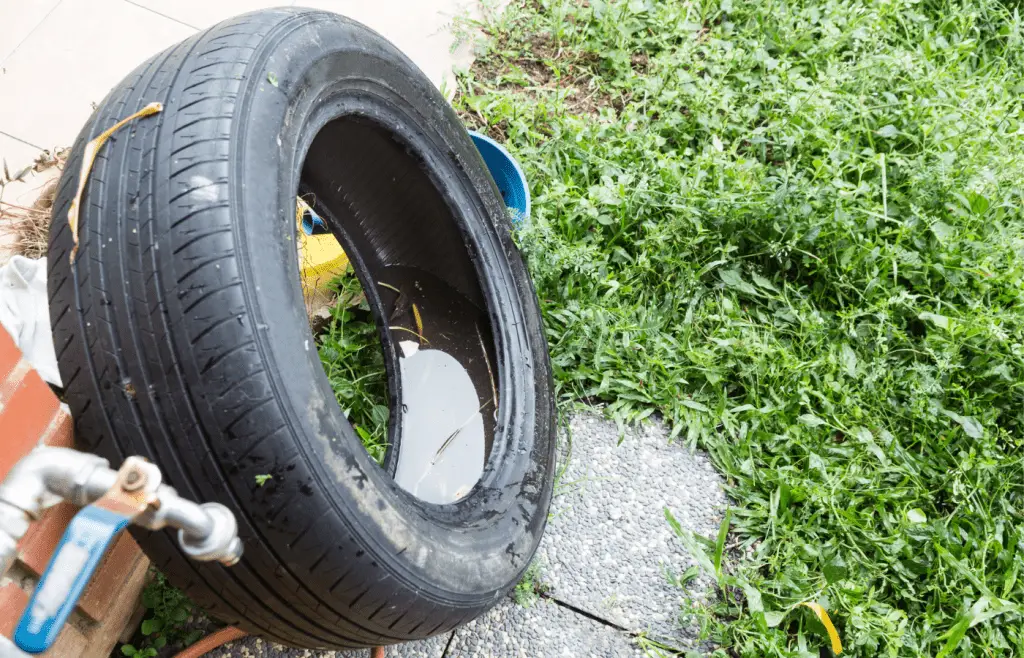Tires are filled with either air or nitrogen. Usually, nitrogen filled tires are marked with a green valve stem so you can differentiate it from a standard air filled tire. Nitrogen molecules are a lot thicker than air molecules which means they are less prone to leaking out of your tire.
But what about water? Can you fill car tires with water? Well, a youtube channel by the name of Life OD did exactly this. They were able to fill up two rear tires of a Nissan 240SX with water and successfully drive it around without any catastrophic damage or events.
Having a car that is running with tires filled with water isn’t ground-breaking in anyway, however it is very intriguing. Although water filled tires are able to be driven on the road, there are many concerns with drivability and safety which are addressed in the upcoming section and video.
What Happens When You Fill Tires With Water?
Filling your tires with water will cause the drivability to change compared to if they were filled with air or nitrogen. In the youtube video made by Life OD, they drove the car under normal driving conditions. The car noticeably felt less maneuverable and more sluggish.
Adding water instead of air in your tires substantially increases the unsprung mass of your cars suspension. Retuning your car’s suspension may alleviate some of this, but this won’t decrease the rotational mass that is added on from the additional weight from the water.
After they are done with normal driving conditions, they decided to just let loose. They did a huge burnout until the tires actually exploded, sending water everywhere.
Why Do People Fill Tires With Water?
One of the most common instances where people will fill their tires with water is with off-road vehicles. Using liquid ballast in off-road tires is a common practice.
Liquid ballast adds a good amount of weight to the vehicle’s drive axle, which can help to improve traction and performance.
Some other benefits to using liquid ballast in your tires is less tire pressure loss, less fuel consumption, and less slipping while driving off-road.
To check the current price and availability of Phantom Liquid Ballast, click here to view the listing on Amazon.
How Do I Add Water to My Tires?

Since valve stems are made for adding air, you are going to have to get a little creative when adding water to your tires. In the video from Life OD, they deflated the tires and had them slightly off the rim in order to fit a hose in between.
This may not be the most practical way to inflate your tires with water, but it works. Special liquids like Liquid Ballast need a special device that pumps the liquid into the tire.
These devices are mostly used on tractor tires to add liquid ballast to since their tires are heavily prone to punctures, but there are also smaller ones that are designed to fit on a regular valve stem. These are more commonly used for off-road tires.
Frequently Asked Questions
Why Don’t We Fill Tires With Water?
Air and nitrogen will always be more optimal than water or liquids when inflating tires. Air and nitrogen provide lighter rotation mass, increased agility, and provides an overall safer driving experience.
Accessibility and ease of use is another reason why we don’t fill tires with water. If your tire pressure is running low, you can simply stop at your nearest gas station and fill your tires with air at the nearest air machine.
Filling a tire with air is self-explanatory and is simple to learn if you’ve never done it before. It’s also not messy at all. Imagine having to inflate all your tires with water. There are bound to be messes from over inflated tires, or leaks in the hoses.
Can Water Ruin Your Tires?
Water will not ruin your tires. The materials and rubber that tires are made out of have excellent strength. Tire rubber is naturally resistant to water, however, rubber can deteriorate if exposed to oil, different types of car fluids, and car cleaning chemicals such as tire shine.
Do Tires Soak up Water?
In a majority of cases, tires are not able to absorb tangible amounts of water. Rubber is naturally water resistant and will not actively absorb water.
Some common instances where your tire may get water inside is if your tire is punctured, of you have damaged wheels.
Final Thoughts
Tires can be filled with water or other types of liquids, however, this will be in rare instances, such as off-road vehicles, or for some type of experiment like the youtube channel Life OD.
Air and nitrogen are king when it comes to inflating your tires. They have a low unsprung mass, which increases the handling in your car, is easy to refill since almost every gas station has an air machine, and blowouts won’t be as catastrophic as water filled tires might cause.
Adding water or other liquids in tires is not ground breaking, and people have been doing it for different reasons through the years.


